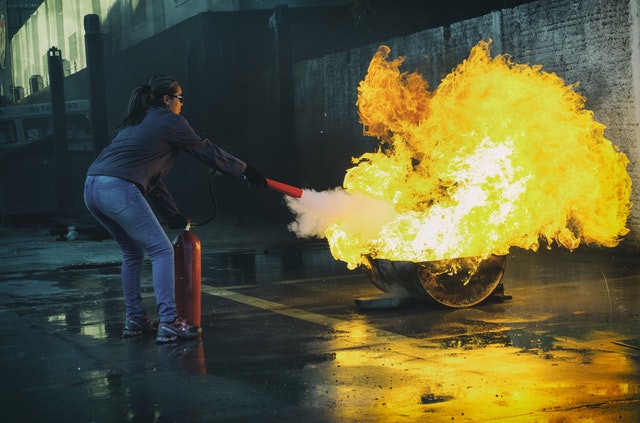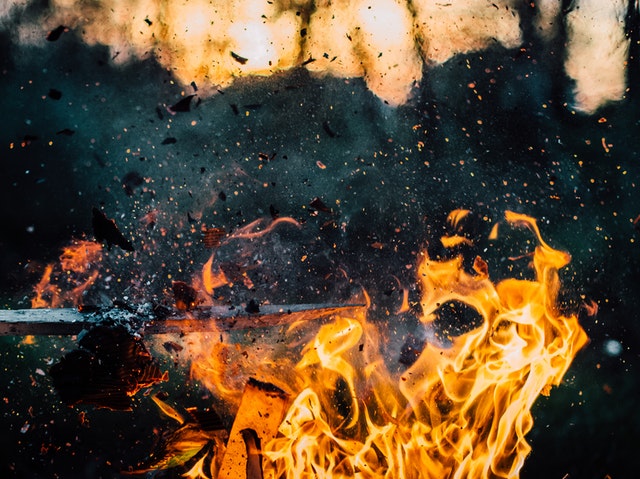
Every house should have a minimum of one fire extinguisher, situated in the kitchen. Better still would be to put in fire extinguishers on each and every degree of a home and in every potentially hazardous place, such as (apart from the kitchen) the garage, furnace room, and workshop.
Pick fire extinguishers with their dimension, course, and evaluation. “Size” refers to the burden of this fire-fighting compound or control, a fire extinguisher comprises, and generally is roughly half the weight of this fire extinguisher itself. For normal residential usage, extinguishers two and a half to five pounds in size are adequate; those weigh five to ten lbs.
“Class” refers to the kinds of fires that an extinguisher can put out. Class A extinguishers are for use only on ordinary combustible materials like paper, wood, and fabric. Normally, their charge is composed of carbonated water, which is cheap and sufficient for the job but rather dangerous if used against dirt fires (the pressurized water may spread the burning grease) and electric fires (the water flow and wetted surfaces can become electrified, providing a potentially fatal jolt ). Class B extinguishers are for use on flammable liquids, such as oil, grease, gas, and other compounds. Normally their fee contains powdered sodium bicarbonate (baking soda).
Class C extinguishers are for electric fires. Most include dry ammonium phosphate. Some Class C extinguishers contain halon gas, but these are not made for residential use due to halon’s adverse influence on the planet’s ozone layer. Halon extinguishers are recommended to be used around expensive electronics such as televisions and computers; the gasoline blankets the flame, suffocating it, then disappears without leaving a chemical residue which could ruin the gear. Another benefit of halon is it assembles to hard-to-reach areas and around obstacles, quenching the fire in areas other extinguishers can’t touch.
Many fire extinguishers include compounds for placing out mix fires; in actuality, extinguishers classed B:C, as well as ARC, are more broadly available for home use than extinguishers designed just for individual kinds of fires. All-purpose ARC extinguishers are the ideal option for any household place nonetheless, B:C extinguishers put out grease fires more efficiently (their cost of sodium bicarbonate reacts with fats and cooking oil to produce a moist foam which smothers the flame ) and so ought to be the primary choice at a kitchen.
“Rating” is a dimension of a fire extinguisher’s effectiveness on a particular form of fire. The higher the score, the more successful the extinguisher is contrary to the course of passion to which the score is assigned. In fact, the evaluation process is somewhat more complex: evaluation numbers assigned to a Class A extinguisher suggest that the approximate gallons of water required to rival the extinguisher’s capacity (by way of instance, a 1A score indicates that the extinguisher works and approximately a gallon of water), whereas amounts assigned to Class B extinguishers indicate that the approximate square footage of fire which can be extinguished by a mean nonprofessional user. Class C extinguishers carry no evaluations.
For security on a whole floor of a home, purchase a comparatively big extinguisher; for instance, a version rated 3A:40B:C. These weigh about ten pounds and cost approximately $50. In a kitchen, select a 5B:C device; those weigh around three pounds and cost approximately $15. For greater kitchen security, it’s probably better to purchase two little extinguishers than just one bigger version. Kitchen fires generally start small and may be managed by a small extinguisher; smaller extinguishers are more manageable compared to bigger ones, particularly in confined spaces; yet, because a partially used extinguisher has to be recharged to prepare it for additional use or substituted, having multiple tiny extinguishers makes better sense.
A 5B: CAmp is also a fantastic selection for shielding a garage, where dirt and petroleum fires are probably. For assignments, utility rooms, and related places, acquire IA: lOB:C extinguishers. These, also, weigh around three pounds (some weigh up to five pounds) and cost approximately $15. In all circumstances, purchase just extinguishers listed by Underwriters Laboratories.
Mount fire extinguishers in plain sight on walls near doors or other possible escape routes. Use mounting brackets created for your purpose; those connect with extended screws to wall studs and permit extinguishers to be immediately eliminated. Rather than the plastic mounts that come with a lot of fire extinguishers, think about the sturdier sea mounts accepted by the U.S. Coast Guard. The proper mounting height for extinguishers is between four and five feet above the ground, but bracket them as large as half an hour if needed to keep them from the reach of young kids. Don’t maintain fire extinguishers in cabinets or someplace from sight; in a crisis, they’re very likely to be missed.
Purchase fire extinguishers which have pressure indicators that allow you to look at the state of the fee at a glance. Inspect the estimate once a month; possess an extinguisher recharged where you purchased it through the regional fire department if the judge suggests it’s dropped pressure or after it’s been utilized, even if just for a couple of seconds. Fire extinguishers that must not be recharged or have outlasted their rated lifespan, which can be printed on the tag, must be substituted. In no case, if you maintain a fire extinguisher for more than ten decades, whatever the maker’s claims. Regrettably, recharging a more compact extinguisher often costs almost as much as replacing it may not revive the extinguisher to its initial state. Wasteful as it looks, it’s normally better to replace many residential fire extinguishers as opposed to have them recharged. To try it, release the extinguisher (the contents are nontoxic) to a plastic or paper bag, then discard the bag along with the extinguisher from the garbage. Aluminum extinguisher cylinders can be recycled.
Everybody in the family except young kids ought to practice with a fire extinguisher to find out the method if a fire breaks out. A fantastic means to do so is to disperse a huge sheet of plastic on the floor and use it as an evaluation place (the contents of the majority of extinguishers will kill grass and blot pavement). To operate a fire extinguisher correctly, stand or kneel six to ten feet in the fire with your back to the closest exit. (If you can’t get within six feet of a fire due to smoke or extreme heat, don’t attempt to extinguish evacuate the house and call the fire department.) Holding the extinguisher upright, pull the locking pin from the grip and then aim the nozzle at the base of the flames. Then squeeze the grip and then extinguish the flame by sweeping the nozzle from side to side to blanket the flame with retardant before the flames go out. Watch for fires to renew, and also be ready to spray.
Chimney Fire Extinguishers
If you run a fireplace or wood-burning stove, then continue hand three or two oxygen-starving sticks, available at fireplace and woodstove dealers. In the event of a chimney fire, then tossing the sticks to the fires will immediately quench a fire in the chimney flue or stovepipe. Evacuate the home and call the fire department immediately in any circumstance.
For more details please visit: How to Use a Fire Extinguisher


